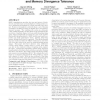Free Online Productivity Tools
i2Speak
i2Symbol
i2OCR
iTex2Img
iWeb2Print
iWeb2Shot
i2Type
iPdf2Split
iPdf2Merge
i2Bopomofo
i2Arabic
i2Style
i2Image
i2PDF
iLatex2Rtf
Sci2ools
ISCA
2010
IEEE
2010
IEEE
Dynamic warp subdivision for integrated branch and memory divergence tolerance
SIMD organizations amortize the area and power of fetch, decode, and issue logic across multiple processing units in order to maximize throughput for a given area and power budget. However, throughput is reduced when a set of threads operating in lockstep (a warp) are stalled due to long latency memory accesses. The resulting idle cycles are extremely costly. Multi-threading can hide latencies by interleaving the execution of multiple warps, but deep multi-threading using many warps dramatically increases the cost of the register files (multi-threading depth × SIMD width), and cache contention can make performance worse. Instead, intra-warp latency hiding should first be exploited. This allows threads that are ready but stalled by SIMD restrictions to use these idle cycles and reduces the need for multi-threading among warps. This paper introduces dynamic warp subdivision (DWS), which allows a single warp to occupy more than one slot in the scheduler without requiring extra registe...
Hardware | Idle Cycles | ISCA 2010 | Multi-threading | SIMD |
| Added | 10 Jul 2010 |
| Updated | 10 Jul 2010 |
| Type | Conference |
| Year | 2010 |
| Where | ISCA |
| Authors | Jiayuan Meng, David Tarjan, Kevin Skadron |
Comments (0)

